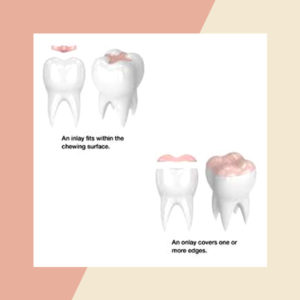Inlays & Onlays

Do you have cavities? If yes, do you know they can destroy your oral health? To combat cavities, you’ll need something strong, i.e. inlays and onlays. Never heard of that? Well, yes dental fillings and implants are generally performed to get rid of tooth decay. But, inlays and onlays are also effective methods to prevent cavities from spreading. They are basically considered dental restoration treatments since they help to restore the condition of your teeth.
But, what are inlays and onlays? Let’s dive deeper into what they mean and how they work.
What are Inlays and Onlays?
Inlays:
When cavities eat your tooth, inlays come to rescue your mouth. They act as an alternative to dental fillings and imitate natural tooth structures. Traditional inlays were made from only one component i.e. gold. Nowadays, ceramics and porcelain inlays have replaced gold inlays in households.
Onlays:
Dental inlays and onlays have striking similarities, and the only difference between them is being able to cover large spaces. Where inlays are preferable to fill hollow spaces of the teeth, onlays are used to cover larger spaces of the tooth.
They are widely used to cover tooth decay and preserve the tooth structure. Onlays are also made from composite material and porcelain.
The Benefits
Here are some of the benefits of inlays and onlays:
- Durability: Inlays and onlays, as stated above, are made of materials such as porcelain, gold, or composite resin, which are stronger and more durable than traditional amalgam or composite fillings. This means they can last longer and withstand the forces of biting and chewing.
- Better fit: Inlays and onlays are custom-made to fit the exact shape and size of a tooth, providing a tight, snug fit that helps to prevent decay or wear. This results in a better seal, which helps to keep food and bacteria from getting into the tooth and causing decay.
- Aesthetic appeal: Inlays and onlays can be made from materials that closely match the color of the natural teeth, making them an excellent choice for people who want a cosmetic restoration that looks natural and blends in with their smile.
- Minimal removal of healthy tooth structure: Inlays and onlays require only minimal removal of healthy tooth structure, which helps to preserve the integrity of the tooth. This is in contrast to traditional crowns, which require extensive removal of healthy tooth structures in order to fit properly.
- Better oral health: Inlays and onlays help to maintain good oral health by providing a strong, sealed surface that helps to prevent decay and gum disease.
Overall, inlays and onlays provide a durable and long-lasting restorative solution for people who need to repair or restore damaged or decayed teeth.
Who is a candidate for Inlays and Onlays?
Both are typically recommended for patients who have mild to moderate tooth decay or damage and are an alternative to traditional dental fillings. They can be used by people of all ages, provided they have a healthy mouth and enough remaining tooth structure to support the restoration.
The decision to use an inlay or onlay is based on the extent of the tooth damage and the location of the decay. Inlays are typically used to repair small to medium-sized cavities, while onlays are used for larger cavities that affect the biting surface of a tooth or the cusps (points) of the tooth. Your dentist in Dallas Tx will be able to determine whether an inlay or onlay is the best option for you based on a comprehensive evaluation of your oral health.
What are the major differences between inlays and dental fillings?
Dental fillings:
- Fillings are made from either composite material or amalgam.
- They are quicker and require only one dental visit.
- They are not durable, but inexpensive.
- They are available in different colors.
Inlays:
- Inlays, on the other hand, are solid tooth-like pieces made from either ceramic, porcelain, or gold.
- They are manufactured in a lab and would require more than one dental visit.
- They are durable (last around 25 to 30 YEARS!) and a bit expensive.
- Inlays are almost invisible.
What are the major differences between onlays and dental crowns?
Dental crowns:
- Dental crowns are significantly different from onlays because of being able to cover the top and sides of the tooth.
- They are either made entirely from porcelain or from ceramics.
- They are a bit high in price.
- They protect the tooth from tooth decay and breaking.
Onlays:
- Onlays are just used to cover the top of the tooth.
- They can be made from gold or porcelain.
- They last for around 10 to 15 years.
- They are less expensive than a dental crown.
How much are inlays and onlays?
When you are getting dental treatment, prices are usually affordable. For inlays and onlays, a typical one-tooth treatment with basic components would cost around $500 to $600. Whereas, a high-end material such as gold or porcelain, would raise the cost from $1,000 to $1,500.
Many insurance providers cover inlays and onlays treatment. You will have to get in touch with your insurance provider to know whether you have it under your belt or not.
Only a professional dentist can advise what’s best for you. All you have to do is to call us and get the best dental care. Call now to book an appointment!